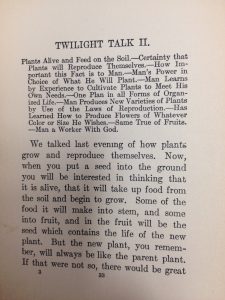The menial aspects of the day to day and the rituals we perform without a second thought form the basis of great life decisions. Chamberlin notes how table manners can differ across cultural boundaries, and when one ascribes to a certain social group they have to adhere to their groups rules, which in turn promotes ‘othering’ (Chamberlin 235). This ‘othering’ has a trickle down effect influencing our social circles, how we act in response to differences, and could eventually lead to conflict and disbelief in the ‘others’ storyline or perspective

However, human memory is short and the values we ascribe to certain knowledge today are foreign to those we identified with just over a hundred year ago. These photos are excerpted from a book on sexual health published in the late 19th century that alludes to the human physiology being much like the reproductive process of plants (Kellogg 23). God is referenced in this passage as well, further emphasizing our use of stories in western society (just as in all other cultures) to explain the day to day.
There is a fault in this analysis. Endless divides exist as we are all individuals. Intersectionality proclaims that we are a part of many social groups, some which contradict each other. It is perhaps this that both avoids and contributes to conflict, particularly when a person wishes to please the masses.
When names are not used properly, language will not be used effectively; when language is not used effectively, matters will not be taken care of; when matters are not taken care of, the observance of ritual propriety and the playing of music do not flourish; when ritual propriety and the playing of music do not flourish, the application of laws and punishments is not on the mark; when the application of laws and punishments is not on the mark, the people will not know what to do with themselves. – Confucius in The Analects, from If This Is Your Land, Where Are Your Stories?
Devastating life events such as war, famine or displacement and homelessness can be attributed to misunderstanding ceremonies, and not seeing a duality of beliefs according to Chamberlin (Chamberlin 229). The Gitskan, as noted in the story about the land claims surrounding the grizzly-earthquake, are an exception, where they believe both storylines. Some may claim that this is because of a financial gain on their part, but I would like to believe that one could respect both trains of thought associated with an event that happened 7,000 years ago. However, these are examples of grand life events. The large blow that leads to a revolution, or destroys a civilization. What about daily conventions?
I found the quote from Confucius to be very applicable to a recent disagreement with my partner. We are making arrangements for our wedding next Spring. Looking at venues I tend to focus on the functionality of a space and he focuses more on the aesthetic value. We both wish for our families and friends to come together next spring and feel comfortable, well fed and hopefully enjoying the festivities of our wedding day. The wedding is a grand event, filled with ceremony and tradition. My partner and I do not ascribe to some of the traditional aspects that originate from the Christian sanctity of marriage, though bits and pieces have seeped through our psyches from families, and these dialogues are deeply engrained in us. Honouring certain traditions will help make our families more comfortable, and to us, there is value in establishing those ties at our ceremony and the events leading up to bringing our families together. Ultimately, having a comfortable space for the ceremony to take place will be both functional and aesthetically pleasing. Otherwise the people will not know what to do with themselves.
References
Chamberlin, J. Edward. If This Is Your Land, Where Are Your Stories?. Chapter 11: Ceremonies. Cleveland, Ohio: Pilgrim Press, 2004. Print.
Kellogg, John Harvey. Plain Facts For Old And Young. Charlottesville, Va.: University of Virginia Library, 1889. Print.
One reply on “Contracts and Ceremonies: Duality of Meaning Existing in Partnerships”
Hi Kendra,
I really enjoyed your post. Your’e analysis of individuality and social groups and the conflicts that can arise from these contradictions really resonated with me (especially the link you included!). The passage from Confucius you chose to include reminded me of one of my favourite quotes from Carl Linnaeus (the 18th Century Swedish Botanist): “If the names are unknown knowledge of the things also perishes”. I think Linnaeus was focused on biological knowledge when he said these words, but I believe that it is applicable to much more than just biology, much as Confucius says in the above passage. If we take both of these quotations together, it is easy to see just how fundamental names are for effective communication, and that when this communication breaks down one gets both the loss of knowledge mentioned by Linnaeus and the complete break down of society implied by Confucius.
Thanks again for a really interesting post, and good luck with the wedding planning!
Cam